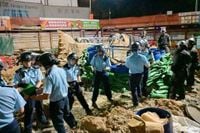Residents of Hong Kong’s bustling Quarry Bay district faced an unexpected and nerve-wracking ordeal on the night of September 19, 2025, as authorities discovered a massive, unexploded World War II bomb buried beneath a construction site. The nearly 5-foot-long, 1,000-pound U.S.-made bomb, packed with 500 pounds of TNT, brought the neighborhood to a standstill and triggered one of the city’s largest emergency evacuations in recent memory.
The drama began when construction workers at No. 16-94 Pan Hoi Street stumbled upon the enormous relic. According to Hong Kong Police, the object was quickly identified as a bomb dating back to the Second World War. "We have confirmed this object to be a bomb dating back to World War II," police official Andy Chan Tin-Chu told reporters ahead of the high-stakes operation, as reported by Reuters and the Associated Press. He emphasized the gravity of the situation, stating, "because of the exceptionally high risks associated with its disposal, approximately 1,900 households involving 6,000 individuals were urged to evacuate swiftly."
As news spread, thousands of residents—many still in their pajamas or hastily packed with essentials—streamed out of their homes into the humid Hong Kong night. The urgency was palpable. The city’s emergency services, well-drilled but facing a rare challenge, set about cordoning off the area and coordinating the evacuation. The Hong Kong Police Force, in an alert posted to X (formerly Twitter), explained, "Given the high risks involved in the handling of the bomb that officers from our Explosive Ordnance Disposal (EOD) Bureau believe to still be in good condition—HKPF devised the emergency evacuation plan upon the discovery of the bomb by workers in a construction site at No. 16-94 of Pan Hoi Street—for the sake of ensuring public safety."
For the bomb disposal experts, the situation was fraught with peril. Not only was the bomb itself a deadly threat, but the weather added another layer of difficulty. The disposal team, according to Fox News and the Associated Press, "braved the elements under the typhoon" as they worked through the early hours of Saturday, September 20. The operation began around 2 a.m. and stretched nearly ten grueling hours, with the team meticulously dismantling the bomb piece by piece. By 11:48 a.m., the threat was finally neutralized. In a city where space is at a premium and construction is constant, this was a close call that could have ended much differently.
Remarkably, no injuries were reported. The professionalism and composure of the bomb squad, as well as the cooperation of the evacuated residents, were credited for the successful outcome. Images released by Hong Kong Police showed the tense moments as officers, clad in protective gear, prepared to defuse the device under the glare of floodlights and the looming threat of the typhoon. The shell of the bomb, after the operation, served as a stark reminder of the city’s wartime past.
This isn’t the first time Hong Kong has had to confront its buried history. Bombs from World War II are unearthed from time to time, a legacy of the city’s strategic importance during the conflict. In 2018, another 1,000-pound bomb was discovered and defused at a construction site in Hong Kong’s business district. That incident, like the most recent one, required the evacuation of thousands and a delicate, hours-long operation by bomb disposal teams. According to coverage by Fox News, the 2018 bomb was the third such device found that year alone.
To understand why these relics keep surfacing, it’s worth recalling Hong Kong’s wartime story. During World War II, the city was occupied by Japanese forces and transformed into a military and shipping hub for the Japanese Empire. The United States, alongside other Allied forces, targeted Hong Kong in a series of air raids designed to disrupt Japanese supply lines and infrastructure. The bombs dropped during those raids, sometimes failing to detonate, became a hidden danger lurking beneath the city’s rapid postwar development.
The recent incident in Quarry Bay is a vivid illustration of how the past can quite literally explode into the present. As the city’s skyline continues to climb and old neighborhoods are redeveloped, the risk of uncovering unexploded ordnance remains a sobering reality. "Bombs left over from World War II are discovered from time to time in Hong Kong," noted the Associated Press, highlighting the persistent legacy of the conflict.
Throughout the operation, authorities prioritized safety above all else. The evacuation, though disruptive, was executed with impressive speed and coordination. Residents—some elderly, some with young children—found temporary shelter in community centers and with relatives, waiting anxiously for the all-clear. For many, the experience was a stark reminder of the city’s vulnerability, even in an era defined by prosperity and modernity.
Once the bomb was finally rendered safe, relief swept through Quarry Bay. Residents returned to their homes, grateful that the only scars left behind were a few frayed nerves and a sizable hole at the construction site. The Hong Kong Police Force, in a statement, praised the "swift action and professionalism" of the Explosive Ordnance Disposal Bureau and thanked the public for their patience and cooperation.
For historians and city planners alike, the episode is a call to remain vigilant. As Hong Kong continues to evolve, the ghosts of its wartime past remain buried—sometimes literally—beneath its feet. Each discovery of unexploded ordnance is a reminder of the city’s resilience and the enduring impact of global conflict on local communities. The Quarry Bay bomb scare may be over, but as construction presses on and the city’s skyline grows ever higher, the past will doubtless surface again.
For now, the people of Quarry Bay can breathe easy, knowing that a dedicated team of experts, working under the most challenging conditions, managed to turn a potential disaster into a story of calm, competence, and community spirit.
